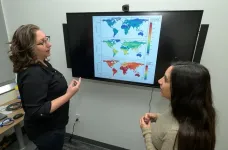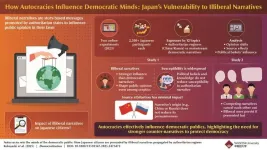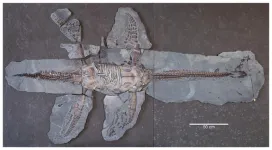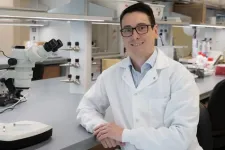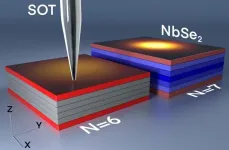(Press-News.org) The method is substantially cheaper and easier to administer than even the best of today’s approaches – making it significantly more viable for healthcare providers.
The invention paves the way for a future restorative treatment for osteoarthritis.
Scientists at Queen Mary University of London have invented a new way to repair osteochondral defects – a common form of joint damage often caused by sports injuries or trauma – and to prevent progression to osteoarthritis.
The treatment uses Agrin, the protein which builds and maintains the link between our motor neurons and muscle fibres. A small soluble polypeptide (a chain of amino acids) derived from Agrin changes the cellular and molecular repair process in our joints to block cartilage degradation and form new cartilage faster. This repairs the damaged cartilage, lessens the pain, restores joint function, and prevents the onset of osteoarthritis – a leading cause of workplace absenteeism.
The method is cheaper, and easier to administer than even the best of today’s approaches – making it more viable for healthcare providers.
The inventors are Prof Francesco Dell'Accio, Professor of Musculoskeletal Regenerative Medicine and Rheumatology, and Dr Suzanne Eldridge, Senior Lecturer of Musculoskeletal Regenerative Medicine – both based at the Centre for Bone and Joint Health at Queen Mary University of London. at Queen Mary University of London.
The pair are starting a new spinout from Queen Mary, ReFleks, backed by Queen Mary Innovation, to turn their finding into a clinical product. The spinout will launch at the BioTrinity conference on 1st and 2nd April.
Prof Francesco Dell'Accio comments:
“Our invention is a substantial step up from today’s approaches. It doesn’t require open surgery, so it’s easier to administer. It’s cheaper, so more health services can adopt it, and it can be done quickly, so athletes can get back in the game quickly and with fewer ongoing issues.”
As well as fixing injuries, the treatment stops osteochondral defects from progressing to osteoarthritis.
Dr Suzanne Eldridge comments:
“Up to half of those who injure a joint, such as through sport or a trauma, go on to develop osteoarthritis – a debilitating condition for which there is no cure. By repairing the damaged cartilage after an injury, we can repair the injury, enabling people to go back to sports and living an active life while preventing the risk of osteoarthritis down the line.”
The global market for isolated cartilage repair was $1.47Bn in 2022 and expected to grow to $4.5Bn by 2027. ReFleks’s substantial advantages mean it’s expected to take a significant share, with annual sales potentially topping $1Bn. The new company is seeking investment to fund drug development.
The innovation emerged from Francesco and Suzanne’s osteoarthritis research at Queen Mary, which found a negative correlation between Agrin in joints and the severity of osteoarthritis, so they hope to one day use it to treat osteoarthritis as well.
Osteoarthritis patients tend to be older, so treatments take far longer to approve as recovery is slower and harder to measure. Targeting younger healthier populations first in their business strategy is the best way to show the treatment’s potential and generate the funding the researchers will need to develop it for other conditions. The method could also be used in animals, especially horses.
END
Queen Mary launches new regenerative medicine spinout to repair joint damage and prevent arthritis
2025-03-31
ELSE PRESS RELEASES FROM THIS DATE:
Make these scientific sessions part of your media coverage
2025-03-31
New York, NY – March 31, 2025 – Register now for a complimentary media pass for the ATS 2025 International Conference in San Francisco. We will have breaking news from the leading international conference for pulmonary, critical care and sleep medicine.
See what scientific sessions we have planned:
Allergy/Immunology
Critical Care
Cellular/Molecular Biology
Bronchiectasis and COPD
Health Equity/Health Disparities
ILD
Pediatrics
Sleep
All registered media will receive a press release one week prior to the conference with ...
Common anticancer drugs may offer new hope to PTEN Hamartoma Tumour Syndrome patients
2025-03-31
During development, cells grow, expand, and migrate to generate tissues and organs in a highly controlled manner. Many intracellular pathways – series of signalling cascades within a cell – regulate these actions to avoid non-programmed growth that could lead to malformations or cancer. One of these pathways is the PTEN / PI3K axis, a complex series of perfectly balanced chemical reactions.
Mutations in the PTEN gene usually result in the overactivation of PI3K and the imbalance of the system. This may trigger the onset of different types ...
Boehringer Ingelheim and Lieber Institute for Brain Development advance development of COMT inhibitors to treat cognitive impairment in neuropsychiatric disorders
2025-03-31
Baltimore, Maryland (March 31, 2025) — The Lieber Institute for Brain Development, a nonprofit research institution dedicated to treating and preventing developmental brain disorders, today announced the progression toward clinical testing of a unique, centrally acting catechol Omethyltransferase (COMT) inhibitor from its collaboration with Boehringer Ingelheim.
COMT is a dopamine-metabolizing enzyme involved in the regulation of neurotransmitter levels. These are critical for cognitive and behavioral processes that are impaired in several neuropsychiatric disorders. While peripherally ...
WSU researchers develop machine learning model to predict virus reservoirs
2025-03-31
PULLMAN, Wash. — A new artificial intelligence tool could aid in limiting or even prevent pandemics by identifying animal species that may harbor and spread viruses capable of infecting humans.
Created by Washington State University researchers, the machine learning model analyzes host characteristics and virus genetics to identify potential animal reservoirs and geographic areas where new outbreaks are more likely to occur. The model focuses on orthopoxviruses — which includes the viruses that cause smallpox and mpox.
The researchers recently published a study on their work using the model ...
Do authoritarian narratives shape Japanese public opinion?
2025-03-31
An authoritarian regime is a type of government system where power is restricted in the hands of a single leader or a group, limiting the participation of citizens in decision-making. As authoritarian states like China and Russia intensify their global information campaigns, a new study highlights Japan’s vulnerability to illiberal narratives. This research, led by Professor Tetsuro Kobayashi of Waseda University, Research Associate Yuan Zhou of Kobe University, Ph.D. student Lungta Seki of Koç University, and Professor Asako Miura of Osaka University, was published online on March 12, ...
New plesiosaur discovery sheds light on early Jurassic evolution and plausible endemism
2025-03-31
A nearly complete specimen of Plesiopterys wildi from Germany provides fresh insights into plesiosaur diversity and regional specialisation
A newly described plesiosaur fossil from southern Germany is providing crucial evidence about the diversification of these ancient marine reptiles during the Early Jurassic. Published in PeerJ Life and Environment, the study details the discovery and analysis of an exceptionally well-preserved Plesiopterys wildi specimen, which offers new clues about the evolution and geographic distribution of plesiosaurs in Europe nearly 180 million years ago.
Unearthed ...
Chance discovery improves stability of bioelectronic material used in medical implants, computing and biosensors
2025-03-31
HOUSTON – (March 31, 2025) – A chance discovery led a team of scientists from Rice University, University of Cambridge and Stanford University to streamline the production of a material widely used in medical research and computing applications.
For over two decades, scientists working with a composite material known as PEDOT:PSS, used a chemical crosslinker to make the conductive polymer stable in water. While experimenting with ways to precisely pattern the material for applications in biomedical optics, Siddharth Doshi, a doctoral student at Stanford collaborating with Rice materials scientist Scott Keene, ...
Using artificial intelligence to calculate the heart’s biological age through ECG data predicts increased risk of mortality and cardiovascular events
2025-03-31
Vienna, Austria- 31 March 2025 - While everybody’s heart has an absolute chonological age (as old as that person is), hearts also have a theoretical ‘biological’ age1 that is based on how the heart functions. So someone who is 50 but has poor heart health could have a biological heart age of 60, while someone of 50 with optimal heart health could have a biological heart age of 40.
Researchers presenting a new study today at EHRA 2025, a scientific congress of the European Society of Cardiology (ESC), demonstrated that by using artificial intelligence (AI) to analyse standard ...
“She loves me, she loves me not”: physical forces encouraged evolution of multicellular life, scientists propose
2025-03-31
WOODS HOLE, Mass. -- Humans like to think that being multicellular (and bigger) is a definite advantage, even though 80 percent of life on Earth consists of single-celled organisms – some thriving in conditions lethal to any beast.
In fact, why and how multicellular life evolved has long puzzled biologists. The first known instance of multicellularity was about 2.5 billion years ago, when marine cells (cyanobacteria) hooked up to form filamentous colonies. How this transition occurred and the benefits it accrued to the cells, though, is less than clear.
This week, a study originating from the Marine Biological Laboratory (MBL) presents a striking example of cooperative ...
The hidden superconducting state in NbSe₂: shedding layers, gaining insights
2025-03-31
Researchers have discovered an unexpected superconducting transition in extremely thin films of niobium diselenide (NbSe₂). Published in Nature Communications, they found that when these films become thinner than six atomic layers, superconductivity no longer spreads evenly throughout the material, but instead becomes confined to its surface. This discovery challenges previous assumptions and could have important implications for understanding superconductivity and developing advanced quantum technologies.
Researchers at the Hebrew University of Jerusalem have made a surprising discovery about how superconductivity ...

